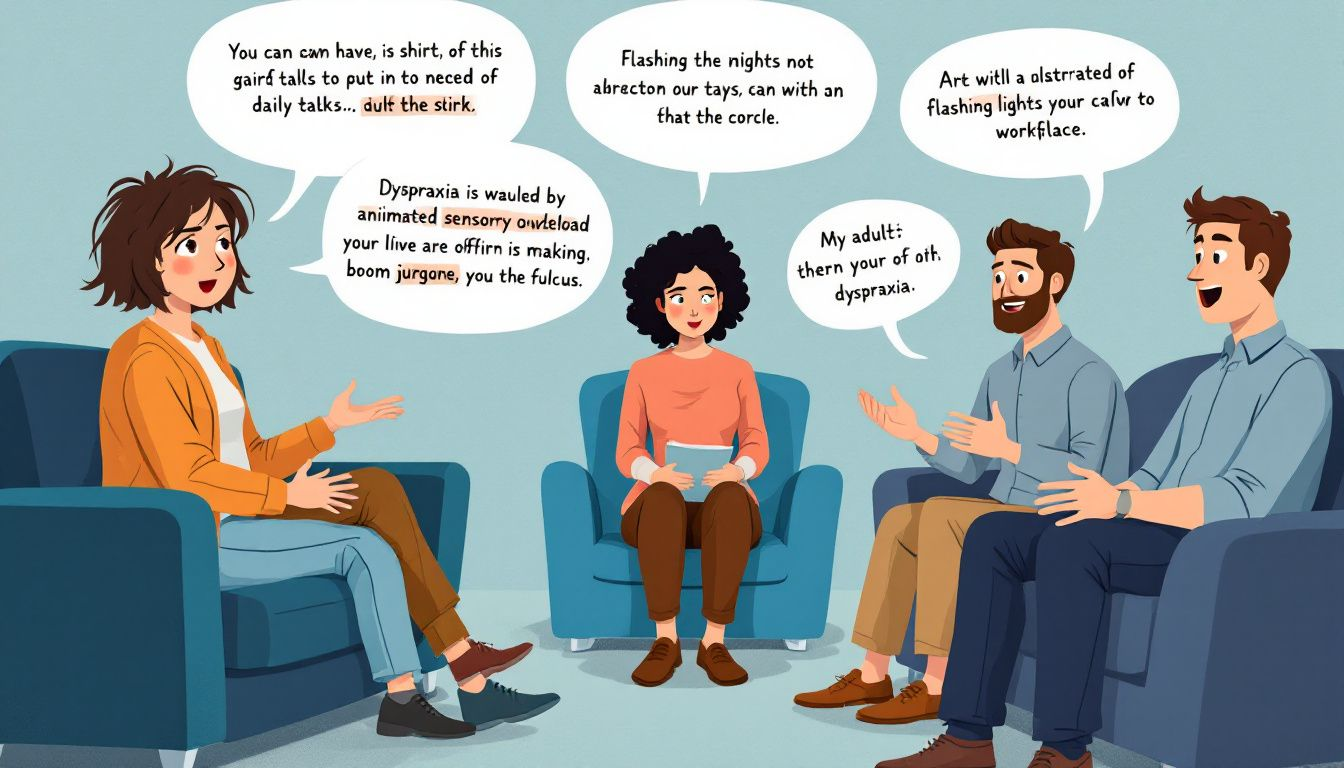Dyspraxia in Adults: Understanding Challenges and Solutions
Dyspraxia in adults is a neurological condition that disrupts coordination and affects daily activities like writing, driving, and meal preparation. Many adults live without a diagnosis, making it hard to find proper support. This article offers a comprehensive overview of dyspraxia in adults, covering symptoms, diagnosis, management strategies, and support options to help improve daily living.
Key Takeaways
Dyspraxia, a neurological condition affecting coordination and motor skills in adults, varies significantly among individuals, impacting daily life and self-perception.
Early recognition and support for dyspraxia, including occupational and cognitive behavioral therapy, can enhance quality of life and foster greater independence.
Raising awareness and understanding of dyspraxia is essential for reducing stigma, improving societal acceptance, and ensuring individuals receive necessary accommodations and support.
Dyspraxia in Adults: Understanding Challenges and Solutions

Dyspraxia, also known as developmental coordination disorder (DCD), is a neurological condition that primarily affects coordination and fine motor skills without impacting intelligence. It manifests differently in each individual, with symptoms evolving over time. This variability means that recognizing and addressing dyspraxia in adults requires a nuanced and personalized approach.
Adults with dyspraxia often face significant challenges in their daily lives. These challenges can range from difficulties in planning and executing fine and gross motor tasks, such as writing or using small objects, to more complex activities like driving or meal preparation. Routine tasks that most people take for granted can become overwhelming obstacles, leading to frustration and a sense of inadequacy.
Despite these challenges, many adults with dyspraxia live without a full understanding of their condition, which can complicate their ability to seek appropriate support and accommodations. Increasing awareness and understanding of dyspraxia enables individuals to navigate their daily lives more effectively, ultimately enhancing their quality of life.
Introduction
Dyspraxia is a neurological condition that significantly impacts coordination and motor skills, influencing a person’s ability to perform everyday tasks. From dressing and meal preparation to more intricate activities like applying makeup or using utensils, dyspraxia can make seemingly simple actions daunting. Recognizing dyspraxia and providing appropriate support can significantly enhance the quality of life for those affected.
Personal Independence Payment (PIP) can recognize dyspraxia as a disability, providing financial assistance to those who need help with daily living and mobility. However, eligibility is assessed on a case-by-case basis, considering the individual’s specific challenges and the level of assistance required. Effective management of dyspraxia can greatly enhance daily living and overall well-being.
What is Dyspraxia?

Dyspraxia, also known as developmental coordination disorder (DCD) or clumsy child syndrome, is a chronic neurological condition that affects movement and coordination. It is more common in males and can sometimes run in families, indicating a possible genetic link. Despite not affecting intelligence, dyspraxia impacts the ability to perform tasks that require fine motor skills and coordination, such as dressing, cooking, and writing.
Symptoms of dyspraxia symptoms can vary widely among individuals and can change over time. Adults with dyspraxia often face difficulties in planning and completing both fine and gross motor tasks, which can lead to significant challenges in daily living. These coordination difficulties can also extend to social and emotional domains, affecting interpersonal relationships and overall well-being.
Recognizing Dyspraxia in Adults

Recognizing dyspraxia in adults can be complex due to the variability of symptoms and the coping strategies that many adults develop over time. Common signs include struggles with fine motor skills, making tasks like typing or using utensils particularly challenging. Additionally, routine activities such as driving, cooking, and even maintaining personal hygiene can become difficult.
Many adults with dyspraxia may not realize they have the condition, often attributing their difficulties to personal shortcomings rather than recognizing a neurological basis. Understanding the symptoms and acknowledging the condition can be the first step towards seeking appropriate help and support, thereby improving the individual’s quality of life.
Causes of Dyspraxia
The exact causes of dyspraxia remain largely unknown, but research suggests a combination of genetic, neurological, and developmental factors. Dyspraxia often appears to run in families, indicating a potential genetic component. Variations in neuronal development and brain communication are also believed to play a significant role in the manifestation of the condition.
Several risk factors may increase the likelihood of developing dyspraxia, including premature birth, low birth weight, and maternal substance abuse during pregnancy. Despite these insights, much about the origins of dyspraxia remains uncertain, highlighting the need for further research to fully understand the condition.
Diagnosing Dyspraxia in Adults
Diagnosing dyspraxia in adults involves a thorough assessment of medical history, motor skills, and developmental background. Professionals such as clinical psychologists, educational psychologists, pediatricians, or occupational therapists typically conduct these assessments. While there are no specific medical tests for dyspraxia, detailed evaluations can help identify the condition.
Many adults with dyspraxia may not pursue a formal diagnosis, often due to a lack of awareness or understanding of their symptoms. However, keeping a diary of symptoms and consulting with a general practitioner can be beneficial steps towards obtaining a diagnosis and accessing the necessary support.
Living with Dyspraxia: Day-to-Day Challenges

Living with dyspraxia presents various day-to-day challenges that can affect multiple aspects of life, from coordination and balance to the ability to perform routine tasks. Practical activities such as getting dressed, cooking, cleaning, and driving can become particularly challenging. These difficulties can lead to emotional issues, including low self-esteem, anxiety, and frustration.
Dyspraxia also impacts social and professional life, affecting communication abilities, job situations, and social interactions. Managing these challenges often involves developing coping strategies and utilizing assistive technologies and workplace accommodations. Dyspraxia affects these areas significantly.
The subsections below will delve deeper into these strategies.
Enhancing Daily Life with Assistive Technologies
Assistive technologies play a crucial role in helping adults with dyspraxia manage their day-to-day tasks more effectively. Tools such as speech-to-text software and digital organizers can help individuals keep track of their responsibilities and improve their productivity. For those who struggle with handwriting, using thick grips on pens and markers or textured paper can make a significant difference.
Computers can also be incredibly beneficial, offering features like word processors that facilitate writing tasks and allow for easier editing and spell-checking. Developing touch-typing skills can further enhance the efficiency of using these technologies, making it easier to manage everyday tasks.
These practical tools can greatly improve independence and confidence for adults with dyspraxia.
Strategies for Workplace Success
Success in the workplace can be challenging for adults with dyspraxia, but there are strategies that can help. Communicating with employers about the condition and inquiring about available support and adjustments is essential. Employers are responsible for providing these accommodations to ensure a conducive work environment and to prevent discrimination.
Adults with dyspraxia often develop unique skills such as determination, problem-solving, and creativity, which can be valuable assets in the workplace. Recognizing these strengths and leveraging them can lead to greater success and job satisfaction. Additionally, fostering an understanding and supportive workplace culture can help mitigate social challenges and enhance overall productivity, along with strong organizational skills.
Treatment and Support Options
Various treatment and support options are available to help individuals with dyspraxia manage their daily living skills and improve their quality of life. These include occupational therapy, speech and language therapy, and cognitive behavioral therapy. Support networks, such as online forums, provide a sense of community where individuals can share their experiences and find resources.
Referrals to specialists like physiotherapists or occupational therapists can be crucial in addressing motor skills and other symptoms, including perceptual motor training. The subsections below will explore these treatment options in more detail, highlighting their benefits and applications.
Occupational Therapy
Occupational therapy is essential for adults with dyspraxia, focusing on improving both fine and gross motor skills to enhance independence and daily living. Occupational therapists work with individuals to develop routines and strategies for managing everyday tasks, from tying shoelaces to organizing daily activities.
This type of therapy helps individuals maintain their independence by providing practical solutions to overcome the challenges posed by dyspraxia. Tailored treatment plans in occupational therapy significantly improve the ability to perform routine tasks and manage the condition effectively.
Speech and Language Therapy
Speech and language therapy can be particularly beneficial for individuals with verbal dyspraxia, addressing communication difficulties and improving clarity of speech. Therapists work with individuals to enhance their auditory skills and develop strategies for clearer communication, which is crucial for both personal and professional interactions.
This type of therapy not only helps with speech but also fosters better understanding of non-verbal signals and overall communication skills, making it easier for individuals to navigate social situations and express themselves more effectively.
Cognitive Behavioral Therapy
Cognitive behavioral therapy (CBT) is another valuable treatment option for adults with dyspraxia, helping them manage anxiety, low self-esteem, and other emotional challenges. CBT focuses on altering thought patterns and behaviors, promoting positive thinking and constructive coping mechanisms.
By addressing the mental and emotional aspects of dyspraxia, CBT can lead to significant improvements in quality of life. This therapy helps individuals develop resilience and better manage the social and professional challenges associated with their condition.
Co-occurring Conditions

Dyspraxia often co-occurs with other conditions such as ADHD, dyslexia, and anxiety, making it important to recognize and address these additional challenges. These co-occurring conditions can compound the difficulties faced by individuals with dyspraxia, affecting their coordination, learning, and social interactions.
Understanding the interplay between dyspraxia and these co-occurring conditions is crucial for developing comprehensive treatment plans that address all aspects of an individual’s needs. This holistic approach can significantly enhance their ability to manage their condition and improve their overall quality of life.
Long-term Outlook and Coping Strategies
The long-term outlook for adults with dyspraxia is generally positive, with many individuals leading healthy and fulfilling lives despite their challenges. Symptoms of dyspraxia typically do not worsen with age, and some very mild symptoms may even diminish over time. However, most individuals will continue to face some level of difficulty throughout their lives.
To cope effectively, adults with dyspraxia often benefit from regular exercise, which can help improve coordination and reduce fatigue. Support networks, including online forums, provide valuable communities where individuals can share experiences and strategies.
Embracing one’s unique strengths, such as creativity and problem-solving skills, as well as new skills, can also be empowering and enhance self-esteem.
Raising Awareness and Reducing Stigma
Raising awareness about dyspraxia is crucial for reducing stigma and fostering acceptance. Misunderstandings and misconceptions about the condition contribute to societal stigma, which can hinder the acceptance and support of adults with dyspraxia. Organizations like the Dyspraxia Foundation play a vital role in educating the public, dispelling myths, and advocating for those affected by dyspraxia.
Social media platforms offer powerful tools for sharing personal stories and raising awareness about dyspraxia, helping to enhance public understanding and reduce stigma. Promoting educational programs and advocacy efforts helps create a more inclusive society that supports and values individuals with dyspraxia.
Summary
Dyspraxia in adults presents a unique set of challenges that can impact various aspects of life, from daily tasks and social interactions to professional success. Understanding the condition, recognizing its symptoms, and seeking appropriate support are essential steps in managing dyspraxia effectively. This guide has explored the intricacies of dyspraxia, including its causes, diagnosis, and treatment options, as well as strategies for enhancing daily life and workplace success.
By raising awareness and reducing stigma, we can create a more inclusive and supportive environment for individuals with dyspraxia. Embracing the unique strengths and abilities of those with dyspraxia can lead to a richer, more diverse society. Let us continue to advocate for greater understanding and acceptance, ensuring that everyone has the opportunity to thrive.
Visit SAMHSA for more information or contact us today.
Frequently Asked Questions
Dyspraxia can be associated with positive traits such as creativity, strong problem-solving skills, effective multitasking, excellent verbal abilities, and heightened empathy. These strengths enable individuals to approach challenges from unique perspectives and connect with others on a deeper level.
Dyspraxia is a neurological disorder that impairs coordination and motor skills, affecting adults in their ability to perform everyday tasks efficiently. This can lead to challenges in work, social situations, and personal care.
Dyspraxia can be diagnosed in adults through evaluations of medical history and motor skills conducted by qualified professionals, including psychologists and occupational therapists. A comprehensive assessment is crucial for an accurate diagnosis.
Adults with dyspraxia often face difficulties with fine motor skills, time management, organizational challenges, and social interactions. These obstacles can significantly impact their daily functioning and overall quality of life.
Adults with dyspraxia can benefit from treatment options such as occupational therapy, speech and language therapy, and cognitive behavioral therapy. These therapies aim to improve motor skills, communication, and overall coping strategies.





